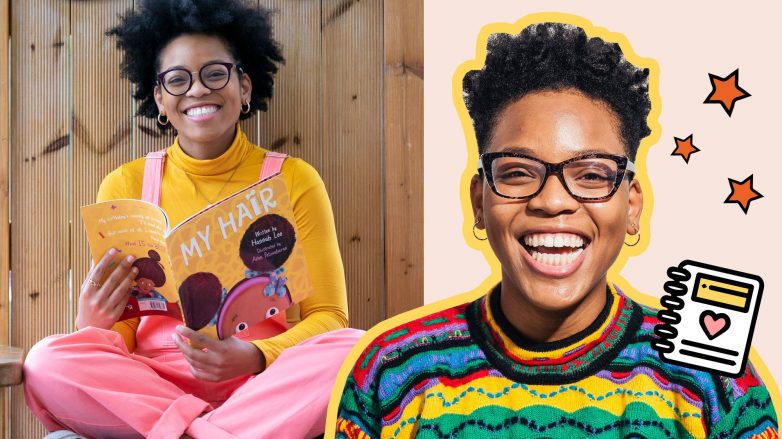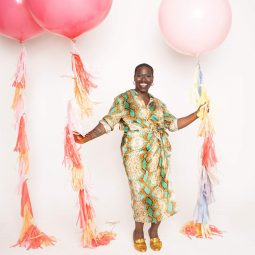What Inspired Me to Write a Children’s Book About Black Hair
Here, rising Author Hannah Lee shares the reasons why she felt it was so important to represent black children and their hair in her debut book 'My Hair'. She also details all the pivotal moments in her own hair journey and life that inspired her.
Hair Types
You Will Need
If you think back to your favourite childhood book, the one that you would read again and again, you’ll probably remember how it made you feel. It could be the thrill of an adventure, the thought provocation of a mystery, or perhaps you related to one of the characters in some way and lived the story through them. It is this latter point that captivates us and carries through into our reading habits as adults. But this point is also frequently not the case for people of colour, as sadly they have been excluded from much of children’s literature to date.
However, one author is changing this with her debut book ‘My Hair’ which aims to bring about more representation of BAME within children’s literature, while also shining a light on the underlying racial issues that perforate our society. We talk with Hannah Lee about her book, her own journey through childhood, and on what needs to be done to bring about change.
Hair, Literature, and Changing the Game
Before embarking on her journey to become an author, Lee was a child just like the rest of us. She went to schools where black students were the majority and this helped to shelter her from some of the racial discriminations that others experience during this time. “All the black children around me had similar hair to mine,” says Lee, who notes that the non-black students were also more unbiased, “the white and Asian children understood and respected the different hairstyles I wore. I was never picked on for my hair.”
And while this may not be the same experience others have while in the schoolyard – which can be a volatile place for anyone – it helped Lee build a more positive outlook on her natural hair, which can take some people a lifetime to reconcile. Luckily, she also had a helping hand at home in the form of her sister, who would help detangle, style, and care for her hair. “She was a pro at styling and caring for natural hair. She knew how to manage my hair and make it look its best, which was important to me. I always felt confident and proud of my hair because of her. She still helps me style my hair now, and her hair transformations inspire me.”

However, Lee couldn’t escape prejudices forever and things took a notable turn when she left the education system and began ventured into the workplace. She was subject to the age-old trial of people touching her hair without permission and although the matter was brought up to her manager at the time, nothing was done about it. “It was a really challenging time for me, as I did not understand why I had to fight so hard to get my point across. I was not used to people just putting their hands in my hair, because I had grown up around a lot of black children and people who knew that was inappropriate.”
Hair is one of the most integral pieces of my identity and, like lots of black women, I use my hair to express myself.
For anyone reading this who doesn’t understand why touching someone’s hair would be inappropriate, the short answer is that it comes down to three things: lack of permission, invasion of personal space, and reducing someone’s hair to a novelty when it has significant ties to identity (you can also read more about this in our quick guide to The Do’s and Don’t of Talking About Black Hair). “Hair is one of the most integral pieces of my identity and, like lots of black women, I use my hair to express myself”, says Lee, noting that this is something that becomes ingrained in black people as they grow up, when they start to try different hairstyles and express themselves creatively through their hair, which in turn helps to develop their identities.
Delving into ‘My Hair’ and the Inspiration Behind the Characters
Lee describes the premise of her book, “My Hair is about a young black girl’s search for the best birthday party hairstyle.” Having experienced the same dilemma of wondering how to style her natural hair when she was younger, Lee elaborates, “I would tell Natalie what I want but would change my mind so much, which is something that the character in My Hair goes through.”
As we have mentioned, hair means everything in black culture and having the freedom to choose how to style it is something to be celebrated, especially in a time where it still is policed. Lee has been lucky enough to grow up with positive role models around her who have taught her how to take pride in her hair, which is something she wants her young readers to feel, too. Evidently, Lee wants to empower her young readers, “I wanted to give black children a chance to see themselves and their unique hair type positively represented.”
In Lee’s book, she showcases an array of black characters with dazzling hairstyles — from dreads to twist outs, all in an effort for black children “to understand that their hair is glorious and versatile.” Lee affirms, “If they can be shown the beauty of their hair in literature, they will learn to embrace and celebrate it for what it is.”
The Importance of Representation in Literature

When recalling all the children’s books she read in Key Stage One (ages 5-7), Lee remembers the name of only two which featured black characters: Handa’s Surprise by Eileen Browne and the Amazing Grace series, by Mary Hoffman. When faced with knowing that her niece and nephew would have to experience the same feeling of alienation, Lee immediately knew she needed to take matters into her own hands and insight change. She mentions, “There are shocking statistics to support the fact that black children are severally underrepresented in literature and the media. A study by the Cooperative Children’s Book Center showed that white children are 50% more likely to see themselves in books, while Black, Asian and Latin children aren’t given the same chance.”
When you see yourself represented in a book, that euphoric feeling of validation never goes away.
Without enough gatekeepers challenging the norm, BAME children are not being properly represented. For change to happen, Lee states, “Publishers need to diversify themselves and actively look for black stories, so they can allow black children and adults to be a part of the narrative. When you see yourself represented in a book, that euphoric feeling of validation never goes away.” Like Matthew Cherry’s Animated Short Hair Love, part of the reason why Lee wrote her book was to give black children a chance to see themselves and feel that sense of belonging.
Tips for Loving Your Natural Hair
Lee’s relationship with her natural hair, from childhood to adulthood, has always been positive, thanks to the people around her. As a child, seeing Natalie (her sister), proudly wear her natural hair, unquestionably influenced Lee’s view on her own hair. Furthermore, Natalie’s role as Lee’s hairstylist, helped Lee learn to love her hair. Recognising the importance of hair-positive role models, she says, “It’s imperative to have these conversations so that black children grow up accepting and loving their hair type.” Lee goes on to explain, “It is all about positivity and teamwork. My sister, who is a mother to two young children, sits them in front of the mirror when doing their hair and praises it.”

Ultimately, those who are struggling need to relearn and keep on learning about their hair to get to a point where they can accept it. Lee finishes by saying, “The great thing is there are so many resources nowadays, whether that’s YouTube or books, that can help. It is trial and error, but constantly learning and finding new ways to manage your hair type is part of the self-love journey”
From all of us here at All Things Hair, we would like to thank Hannah Lee for sharing her story with us. My Hair is available on Amazon. For anyone struggling with their natural hair, we have pulled together a list of our 5 top tips to help you appreciate your natural hair.


